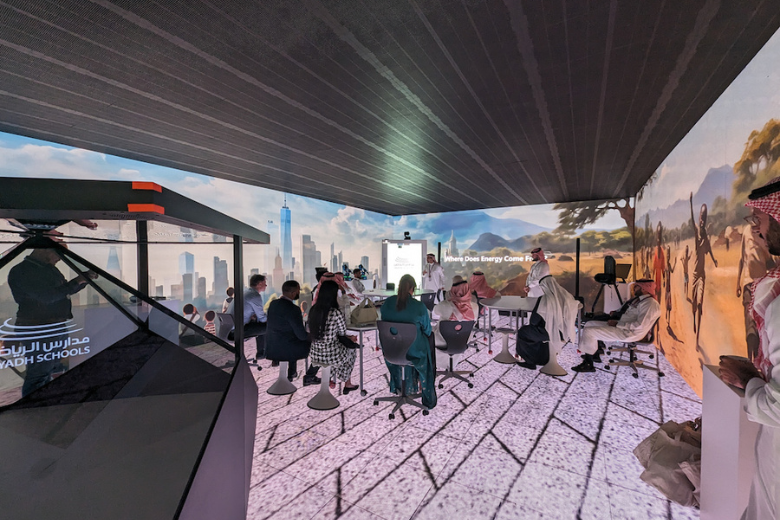Envisioning a Tranquil Learning Environment
Imagine stepping into a classroom transformed; one where the oppressive glare of fluorescent lights and rigid rows of desks are replaced by serene visuals of a calm mountain lake spanning the walls. Gentle ambient sounds fill the air, crafting an atmosphere conducive to tranquility and focus. This may sound like the realm of science fiction, yet it is very much a reality in what is being termed the Classroom of the Future.
As students increasingly grapple with overwhelming academic pressures, pervasive digital distractions, and social anxieties, educational institutions across the United Arab Emirates (UAE) are critically re-evaluating the design and function of learning spaces. More educators are beginning to recognize that fostering student wellbeing may not necessarily commence with counseling, but rather can be effectively rooted in the environment of the classroom itself.

An Adaptive Space Responding to Student Needs
In stark contrast to the traditional classroom, which often presents a cacophony of sounds and a visual overload of decorations, the immersive classroom environment is intentionally designed to adapt to the emotional states of students in real-time. Through the integration of full-wall projections, adaptable lighting, and tranquil soundscapes, educators can effortlessly transform the ambiance of the room with a simple touch. Whether preparing for a demanding exam, calming down after a high-energy activity, or navigating through moments of anxiety, the classroom can morph into surroundings of serenity—be it a tranquil bamboo forest or a peaceful mountain landscape. Incorporating clearly defined mindfulness periods and guided breathing exercises into the curriculum becomes a natural aspect of the daily routine.

For students dealing with anxiety, sensory sensitivities, or attention-related challenges, these subtle adjustments within ESTARS’ mindful classroom environments present a transformative approach to emotional regulation. By creating an atmosphere that promotes focus and calm, learners can reorient themselves effectively without the disruptions often encountered in traditional settings.
Learning that Resonates with Emotion and Intellect
Immersive storytelling techniques enable students to engage with material more profoundly than ever before. Instead of passively consuming information about distant cultures or complex issues, students can experience them firsthand—visiting virtual refugee camps, exploring endangered coral ecosystems, or interacting with holographic peers sharing personal narratives of resilience. This emotional engagement is foundational in cultivating crucial traits such as empathy, emotional intelligence, and resilience, all of which are integral to long-term student wellbeing. The experiential nature of this learning leads to enhanced retention, active participation, and a deeper relational understanding with their peers and the material itself.
Creating Safe Spaces for Difficult Conversations
Addressing sensitive topics such as mental health, body image, and bullying can be challenging, particularly within traditional classroom settings. However, the immersive nature of these environments provides an opportunity to navigate these discussions more comfortably. They offer a respectful and private space where students can reflect, converse, and grow together. With the aid of conversational prompts, AI-powered demonstrations, or pre-recorded peer experiences, even the most reserved students are given new avenues to express themselves. These innovations can have profound, transformative effects on communication skills and self-esteem for students who struggle in conventional settings.
Supporting Educators in the Classroom of the Future
The emotional ramifications of teaching extend far beyond the academic responsibilities of educators. Consequently, the Classroom of the Future also seeks to address the wellbeing of teachers, providing them with opportunities for quiet reflection, meditation, and professional development workshops tailored to their needs. When teachers feel recognized and supported, the energy within the classroom markedly shifts, resulting in a more engaging learning experience for students. Such an environment fosters stronger connections among the entire school community.
Where Innovation Meets Empathy in Education
As educational institutions throughout the UAE increasingly embrace innovative methodologies, there is an emerging recognition of the fundamental truth: wellbeing must be viewed not as an ancillary benefit, but as a core necessity. The Classroom of the Future exemplifies this shift in mindset, skillfully intertwining advanced technological tools with genuine human compassion. In a world where academic success has long been equated with grades and standardized tests, today’s learners require environments that promote holistic growth—spaces where they can breathe, connect, and flourish in a manner that nurtures both the mind and the heart.
Further Reading:
For more insights into innovative educational practices and student wellbeing initiatives, consider exploring additional resources focused on these transformative approaches.
#EducationNews #UAE #CommunitiesNews
